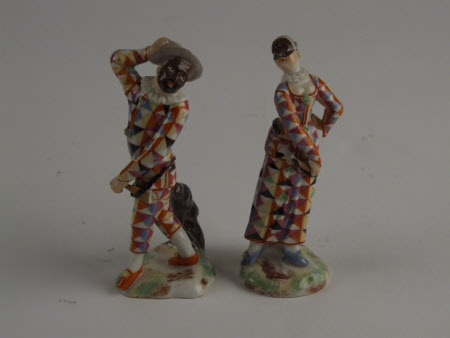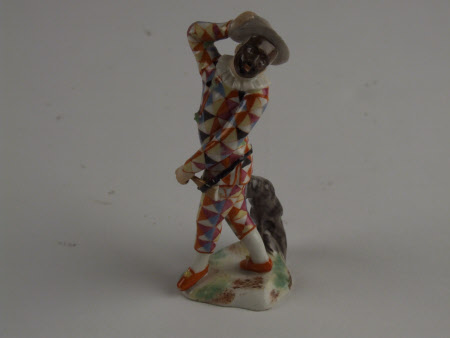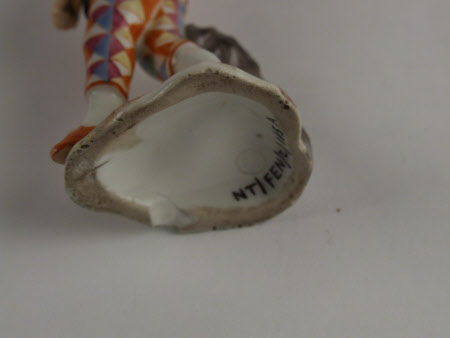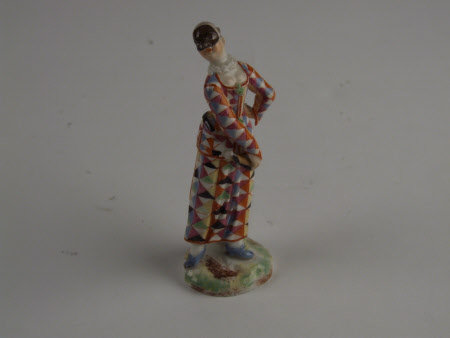Model human
Hochst
Date
1755
Materials
Porcelain
Measurements
8.5 cm (H)
Place of origin
Hochst
Order this imageCollection
Fenton House, London
NT 1448119
Summary
Pair of figures, Harlequin and Columbine (or Harlequine), hard-paste porcelain painted with enamel colours, made by the Höchst porcelain factory, Germany, about 1755. Marked with impressed wheel mark. He in chequered jacket and trousers and a mask, holding his hat on his head with his right hand, in his left hand a slap-stick, she in a similarly chequered costume with pleated ruff, her left hand on her hip and in her right hand a slap-stick. Mark, impressed wheel. Chip to his hat, part of slap-stick lacking.
Full description
In the 18th century, European porcelain figures were made to present and decorate the dessert course of a meal. They replaced earlier types of wax and sugar figures which often expressed political connections and power. The dessert was the most expensive course in the 18th century. Extravagant, edible creations amidst a fine porcelain table setting demonstrated the wealth and fashionable ‘good’ taste of the hosts. Designed to be seen in the round, these porcelain figures were often displayed in thematic groups, down the centre of a table with candelabra, on mirrored glass to enhance the spectacle. Porcelain was, until the 1700s, almost exclusively produced in East Asia and extremely desirable, fetching very high prices in Europe. It was the Meissen factory in Germany who first managed to make a type of hard-paste porcelain, from about 1710. Soon other European factories followed their lead, in response to consumer demand. The Höchst porcelain factory was founded in 1746 by the merchant Johann Christoph Göltz and his son-in-law Felician Clarus. The involvement of former Meissen factor employees, painter Adam Friedrich von Löwenfinck and chemist Johann Jacob Ringler, enabled the factory to produce porcelain from around 1750. Commedia dell'Arte figures were produced at Höchst from 1750 to about 1765.These figures, made about 1755, were inspired by prints of the ‘Commedia dell’arte’ by Johann Jacob Wolrab, Nuremberg, around 1720 .Harlequin (Inv. 1449119.1) was one of the central characters in the ‘Commedia dell’arte’, a form of Italian street theatre involving elaborate costumes and masks. The character was developed from the 16th century as a servant known for his trickery and humour. His love interest is Columbine (Inv.1448119.2) who was a maid to another character, Isabella. She may even represent Harlequine (female counterpart to Harlequin) who was a character in her own right. Their matching clothing, here diamond-patterned, was a popular choice for couples attending festivities. Harlequin and Columbine’s masks could refer to the hide-and-seek aspects of their courtship games. Harlequin can also be depicted with a half-mask or without any mask, instead with exaggerated facial features. In the 18th century the black or brown colour of mask was associated with Harlequin’s rural origins, referring to skin darkened by the sun through outdoor work. Alongside he was also thought to derive from ancient Roman theatre, representing a person of African descent. Harlequin’s black mask could also relate to European depictions of the devil. In the 19th century, versions of these characters were associated with British pantomimes, or performed as afterpiece following a comic opera, such as ‘Harlequin Skeleton’. These were some of the early beginnings of ‘blackface’ shows; a performance tradition in the United States of America, and overseas, for over 100 years from the 1830s. Stereotypes embodied in the stock characters of ‘blackface minstrels’ (white performers [sometimes black performers] painting their skin black and exaggerating their lips) played a significant role in cementing and proliferating racist attitudes.
Provenance
the Marquis of Ripon's Collection
Marks and inscriptions
impressed wheel
Makers and roles
Hochst , maker




